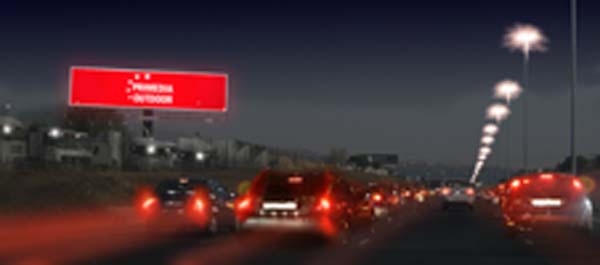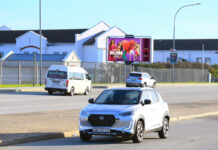Last night (07 March) Primedia Outdoor made African billboard history when it switched on Africa’s first and largest national road LED billboard. It is located in Johannesburg on the NI South between Beyers Naude and Malibongwe Drive.
A huge step forward
Speaking at the launch, Primedia Outdoor CEO Dave Roberts said that while Primedia was no stranger to outdoor or digital, launching the 4.5m X 18m LED was “a huge step forward, not only in the digital space but in the outdoor space too”. He added that not only is Primedia the first to do this on a national road, but also the first to launch “the best quality digital LED screen ever seen along a South African road.”
Regulatory approval
Another first for the outdoor media-owner was obtaining dual regulatory approval. Not only was approval necessary from the Johannesburg City Council, but as the billboard is displayed on a national road approval from the National Roads Agency was also required. The combined approval process took 18-months.
Technology – ahead of the game
On the technology front no expense was spared and the LED screen has 4.2 tons of LED technology on board. The LEDs are Nichia LEDs from Japan and there are 836 352 of them in the display. The huge quantity of LEDs provide a resolution of 264 x 1 056. “This is high resolution for the screen’s size and viewing distance.”
The screen is self-aware to a pixel level. If an individual LED fails, the screen reports the failure remotely giving technicians the precise location of the marred LED.
Calibration software is used to ensure that no one pixel is overly bright, ensuring a uniform image. “This is especially important,” says Dave, “as even though minimum life expectancy is approximately 10 years, some lights will need replacing before others.”
Power saving
One may easily assume that with the high tech used to power the board overall costs may increase. However, this type of LED screen uses up to 75% less power than low costs screens achieving the same brightness. This means the LEDs deteriorate far slower as less heat is generated; and an air-conditioning unit needn’t be installed.
Astronomical numbers
The LED super-sign took three weeks to manufacture and it is no surprise that it took four days to install, using 50 tons of concrete in the foundation. The average super-sign foundation, by comparison, uses 40 tons. The steel structure weighs 15 tons and measures 12.5m from the ground to its top edge.
Stringent testing
Built in a factory in South Dakota, the boards are tested in ovens containing hundreds of infrared lamps, which dial up the heat to over 60 degrees Celsius. The screens operate under these conditions for days before being flash-cooled. This ensures they can tolerate temperature extremes.
Elemental protection
Each LED tile is gel-coated to ensure it is completely watertight, while the structure has been designed to withstand wind forces of up to 140km per hour.
First client
Joining Primedia in this “first-ever” accomplishment is cellular communications company MTN which has signed a three year contract with the media-owner.
“We are pleased to be a part of Primedia Outdoor’s achievement,” commented MTN General Manager of Brand and Communication Ryan Gold at the launch, “and it is entirely coincidental that our partnership ties in with MTN’s new mission: ‘To make our customers’ lives a whole lot brighter’.”
Three-year contract
When questioned on opportunities subsequent to contract expiration, Dave points out that, while not committing himself, it is probable that Primedia Outdoor will have erected several more super-billboards before the MTN contract expires. “Whether or not that materialises,” he says in conclusion, “we have methods to accommodate a number of advertisers. Some of these methods are already in use on several of our established electronic billboards at selected intersections in Johannesburg north.”
Strategically placed
The run-up to the billboard is 700m to 800m, and is exposed to approximately 64 000+ motorists daily.
*Further information from www.primeoutdoor.co.za




















































































